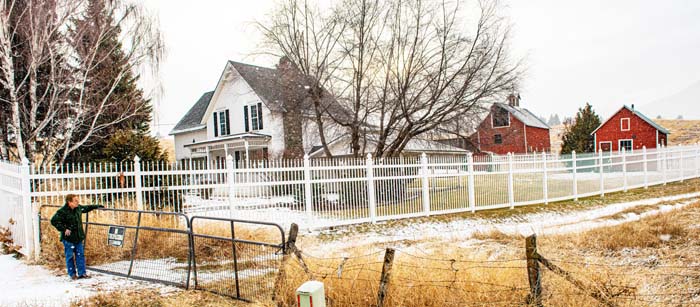Nez Perce Tribe acquires historic Hayes Farm
Published 2:00 pm Wednesday, December 16, 2020

- James Monteith, Eastern Oregon Legacy Lands chairman who supported the Nez Perce Tribe acquisition of the 148-acre Hayes Farm just west of Joseph, gazes across the farm’s historic landscape. The property, purchased by the Nez Perce Tribe on Dec. 9, 2020, holds great cultural and historical significance for the tribe.
JOSEPH — The Nez Perce Tribe recently completed the purchase of the historic Hayes Farm just west of Joseph and south of the Chief Joseph Days rodeo grounds on Airport Road.
The 148-acre property holds great cultural and historical significance for the Nez Perce. According to a press release, the property includes three-fourths of a mile of Wallowa River frontage that may be important in future fisheries management, said Eastern Oregon Legacy Lands Chairman James Monteith.
Nez Perce Tribal Executive Committee Chairman Shannon Wheeler and Secretary Rachel Edwards were there to complete the paperwork Wednesday, Dec. 9.
“This has been a project in the works for some time, and there were several people involved in making this purchase a reality,” Wheeler said. “This purchase is a wonderful step in the reestablishment of a Nez Perce presence in the homeland of our people. We know our ancestors are smiling to see us returning home.”
The property is the second-oldest Century Farm in Wallowa County. Located mostly along the terminal moraine just west of Joseph, it includes what is known as Indian Ridge and Am’sáaxpa (a place of boulders). The property extends from the western edge of the rodeo grounds nearly a mile south to just west of where Ski Run Road crosses the Wallowa River. It includes the house, built in 1884, and barns, cultivated acreage, old growth trees and grassland, as well as riparian river frontage. The property also offers a pristine view of the Wallowa Mountains.
The farm’s property includes a Nez Perce village site, and is known to be a council site for Chief Joseph. The Nez Perce village and teepees are shown in photos at the Wallowa County Historical Society.
The Hayes Farm property’s historical significance includes a meeting between Chief Joseph, accompanied by armed Nez Perce warriors, and U.S. Army Lt. Albert Forse in 1876. The meeting averted immediate conflict between Joseph’s W’al’wama band and the U.S. Army, when Lt. Forse dismounted, laid down his carbine, and walked up the ridge to meet Joseph, who also dismounted and laid down his weapon, according to Grace Bartlett’s book “From the Wallowas,” which briefly describes the Indian Ridge encounter.
During the spring of 1877, Chief Joseph and his band were forced out of the Wallowa Valley. His band at this point consisted of about 400 people, with approximately only 60 warriors. They headed for the Nez Perce reservation in Idaho, crossing the Snake River at what is now Dug Bar in Hells Canyon. At the time they did not know it, but Joseph’s band would never be allowed to return to its homeland. Acquisition of this property will allow the tribe to continue its efforts to preserve its footprint in the area.
The tribe is in the long process of developing plans for the Hayes Farm property. The tribe’s initial statement on Dec. 9 was simply: “Today marks a momentous occasion. We’re coming home!”




